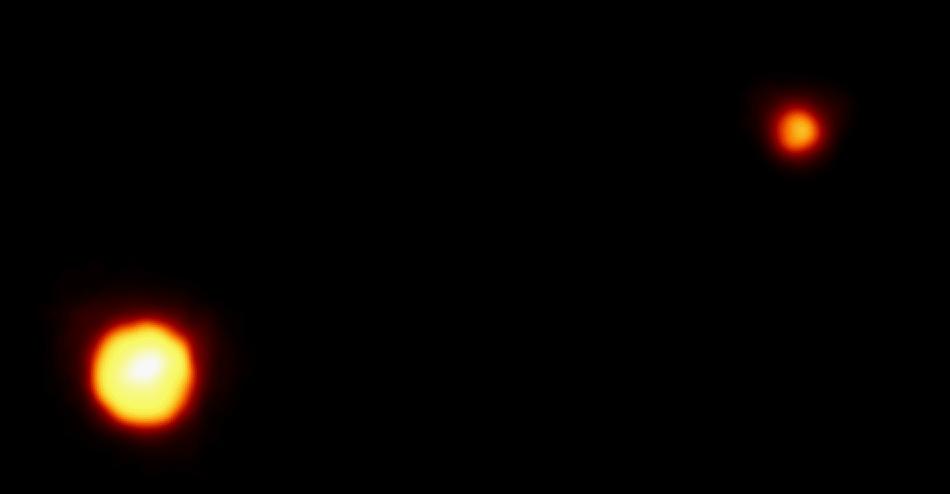







| BOOKS | F. A. Q. | ARTICLES | TALKS | ABOUT KEN | DONATE | BEYOND OUR KEN |
|---|
By Ken Croswell
December 21, 2005

Mining old data from the Hubble Space Telescope, astronomers in Arizona and Colorado have determined the best orbits yet for two newly discovered moons around Pluto. These orbits confirm that Pluto is denser than its largest moon, Charon, suggesting the planet contains a greater proportion of rock.
Astronomers discovered Charon in 1978. Then, in 2005, the Hubble Space Telescope spotted two smaller and more distant moons around Pluto. These new moons are designated S/2005 P1 (the outer small moon) and S/2005 P2 (the inner small moon).
Now Marc Buie and William Grundy of Lowell Observatory in Flagstaff, Arizona, and Eliot Young, Leslie Young, and S. Alan Stern of the Southwest Research Institute in Boulder, Colorado, have analyzed Hubble images that captured the small moons back in 2002 and 2003. These images show the moons making complete orbits around Pluto.
Buie and his colleagues confirm that the orbital periods of P1, P2, and Charon are almost in a 6:4:1 resonance. That is, the outer small moon takes about six times longer than Charon to complete an orbit, and the inner small moon takes about four times longer. Charon orbits Pluto every 6.39 days, while P2 orbits the planet every 24.86 days and P1 revolves every 38.21 days.
Because the new moons feel the gravitational pull of both Pluto and Charon, their motion reveals both the total and individual masses of the planet and its large moon. The scientists find that Charon is 11.65 ± 0.55 percent as massive as Pluto, in agreement with previous work. For comparison, the Earth's Moon is 1.23 percent as massive as the Earth.
The masses also confirm previous signs that Pluto is denser than Charon. Density is important, because it helps reveal what a world is made of. Buie and his colleagues say Pluto is 2.03 ± 0.06 times denser than water, while Charon is 18 percent less dense than Pluto. It is only 1.66 ± 0.06 times denser than water.
Both Pluto and Charon probably consist of silicate rock and water ice. Since rock is denser than ice, and Pluto is denser than Charon, Pluto presumably contains a greater proportion of rock than Charon does.
Buie's team finds that the new moons are almost equally faint, which means they are equally small--if they reflect the same percentage of sunlight. In particular, if both moons reflect 35 percent of the sunlight hitting them, as Charon does, then they are 27 miles, or 44 kilometers, across. But if they are blacker, reflecting only 4 percent of sunlight, they would be three times larger.
For comparison, Pluto is about 1,430 miles, or 2,300 kilometers, across; Charon's diameter, which is better known than Pluto's, is 749 miles, or 1,205 kilometers.
Both Charon and P2 have circular orbits around Pluto. However, P1, the outermost moon, has a slightly elliptical orbit. Its orbital eccentricity is 0.5 percent. Still, that makes the orbit more circular than that of any planet in the solar system.
In just a few weeks, scientists will launch a spacecraft to Pluto. It should reach Pluto and its moons in 2015.
Buie and his colleagues have submitted their work to The Astronomical Journal.
Ken Croswell is an astronomer and the author of Magnificent Universe and See the Stars: Your First Guide to the Night Sky.
"Elegant and eloquent"--Washington Post. See all reviews of Magnificent Universe here.
"Finally! An astronomy guide that the reader can actually follow without being a rocket scientist!" See all reviews of See the Stars here.
| Moon | Discovered | Distance from Pluto (miles) | Distance from Pluto (km) | Orbital Period (days) | Apparent Magnitude
|
| Charon | 1978 | 12,160 | 19,570 | 6.38723 | 16.19
| P2 | 2005 | 30,200 | 48,700 | 24.86 | 23.38
| P1 | 2005 | 40,300 | 64,800 | 38.21 | 23.33
| |
For comparison, the Moon is 238,860 miles, or 384,400 kilometers, from the Earth and takes 27.32 days to orbit it.
| BOOKS | F. A. Q. | ARTICLES | TALKS | ABOUT KEN | DONATE | BEYOND OUR KEN |
|---|